Improving how you teach the PADI Mask Removal and Replacement skill in confined water can help your PADI diving courses run much more smoothly whilst also increasing student diver levels of both comfort and enjoyment. The PADI Mask Removal and Replacement skill in the PADI Open Water Diver course keeps being one of the hardest diving skills for most students to complete on what is probably their first scuba diving experience. Over the years many PADI Dive Instructors have found special teaching techniques and tricks to make it easier for people to master the PADI Mask Removal and Replacement skill.
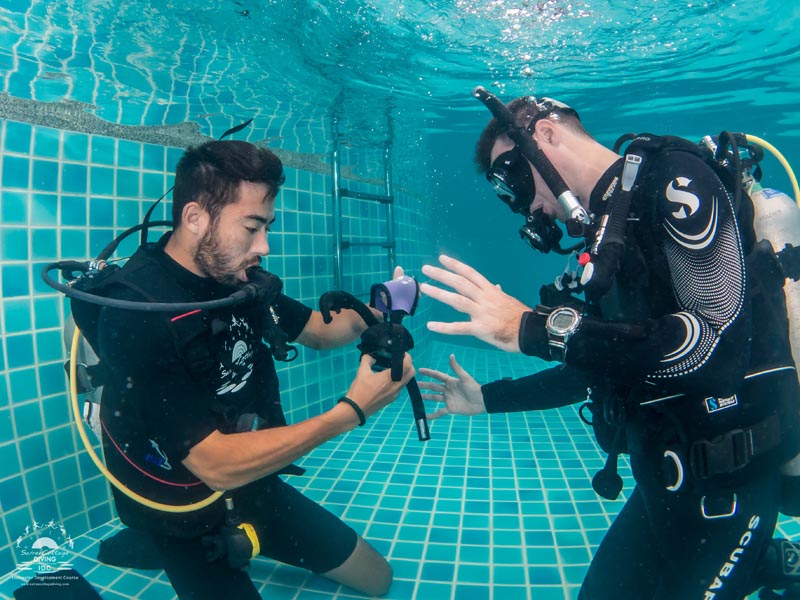
During the PADI Diving Instructor course (IDC) that I teach at Sairee Cottage Diving on Koh Tao in Thailand, I dedicate a special “how to teach the PADI Mask Removal and Replacement” workshop in the classroom and then in confined water to make it easier for my PADI Diving Instructor candidates to go on and teach this skill with real dive students.
So here are my tips on how to teach the PADI Mask Removal and Replacement Skill in confined water. Please don’t forget to leave comments below if you have more tips to share.
Tip 1: Understanding your diving students
The first tip I can give you is about understanding how your PADI Open Water Diver students must be feeling when they find out that they have to take their mask off underwater during their beginner PADI diving course.
While a lot of your diving students will have no problem in removing, replacing and clearing their masks, there will be a few that will get nervous about this even if they haven’t tried it yet. Nerves lead to stress, stress leads to fear, fear can lead to panic and all of this will just make it harder for them to perform the skill. Being nervous significantly impairs people’s ability to think clearly. This is why it’s usually easier to teach children as they have much less fear than older people. If you ask a kid to remove and replace their dive mask underwater they will respond with the answer: “ok… sure” If you ask a grownup the same question they will be more likely to answer: “um…but what if…?”. Past a certain age, people have a tendency to question things more if they perceive safety to be an issue.
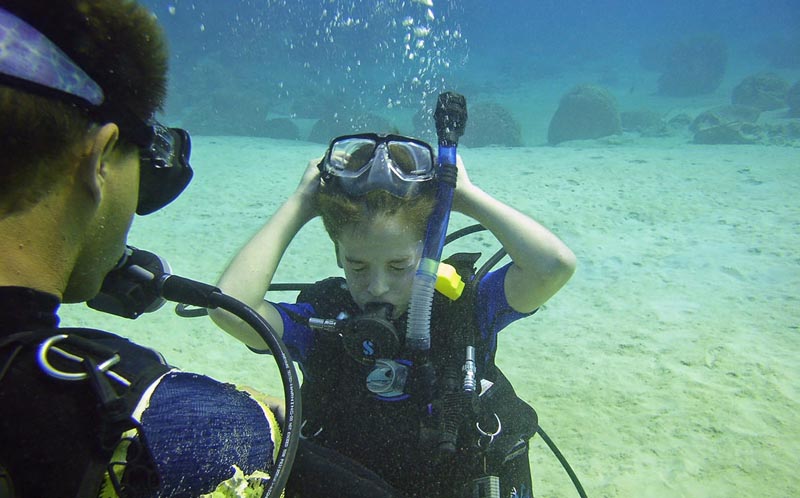
If you understand that diving students can get scared, then you need to be able to recognise it and handle their nerves accordingly. Recognising fear in your PADI Open Water Diver students is quite easy to spot if you pay attention to their eyes. The eyes will always tell you everything. Just by mentioning the PADI Mask Removal and Replacement skill in your dive briefings or in the classroom during the orientation and lectures gives you great opportunities to recognise students reaction and their stress levels before you have even tried the mask removal skill in the pool or confined open water. This will give you an edge in responding to them and organising your group, so they stay closer to you.
Tip 2: Practice clearing the mask on dry land beforehand
Practising clearing the diving mask on land can make your students assume that this is a difficult diving skill to perform. That is something we want to avoid because we want to give the impression that the mask skills are some of the easiest diving skills to complete. It’s all about mind control and human psychology in the end.
What I recommend is that you have your students try and fit the masks in the classroom or anywhere on land and just tell them that you want to get the right size for them. This is not a lie; you need to select their scuba masks anyway for their diving course. Now while they are trying and fitting the different sized masks ask them to blow out of their noses to see if it fits well around the nose area. Ask them to do it at least five times and take this opportunity to check their technique. This is what we call: “Planting the seed” and the brain has now recorded that blowing out of the nose into the mask is easy, an activity they have probably never done before in their lives.
Tip 3: Have your diving students breathe without a mask on the surface
This is an old school trick that many diving instructors use and it works fantastically. At the very beginning of the confined open water or scuba diving pool session, have student divers wear their diving masks around their necks and breathe in shallow water from their regulators with just their faces in the water. This is best to do before you start the confined dive briefing so students don’t see it as a difficult skill, but just a fun activity.
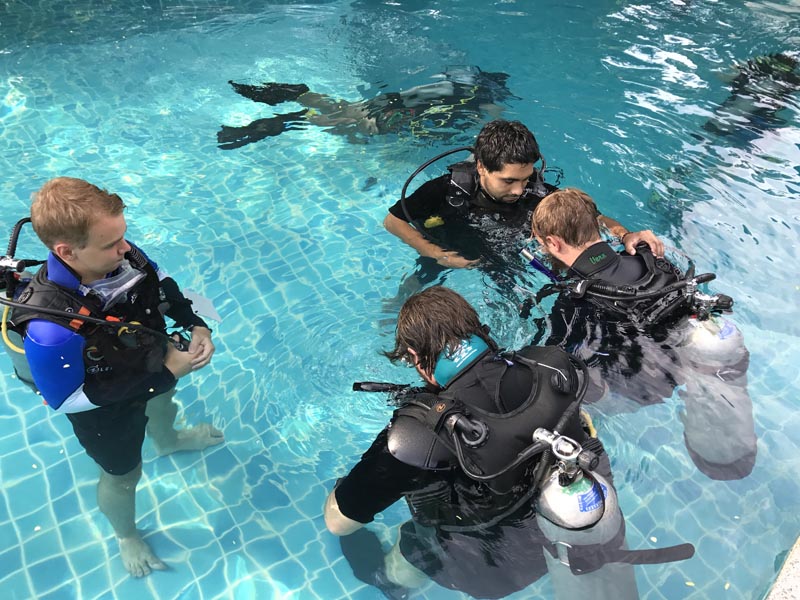
My tip is to not relate this technique to the mask removal and replacement skill or any other another mask skills that you will be teaching soon. Just say it’s to get comfortable breathing through the regulator. With this technique it is very easy to recognise if someone is breathing through their nose as they will instantly stand up. If you already used my first tip then you already have selected the potential problem students, I advise you to stay close to them as that lowers their fear-levels significantly.
If someone does stand up after breathing some water up the nose, then wave it off with a friendly laugh and get them to repeat it. Do this quickly, as waiting too long or talking too much about it will only put the fear into their minds. Once the brain records something as scary it will be much harder to overcome.
If a diving student keeps having a hard time just breathing through their mouths instead of their nose, then I recommend you hold their shoulders gently and close their nose for them for around 45 seconds and then slowly let go of the nose while still holding their shoulder to reassure them. It is very important that your scuba diving student keeps their ears above the water to be able to listen to your advice. Giving advice with a gentle and calming voice while performing this technique will work fantastically as it helps relax the student.
Tip 4: It’s all about the briefing
After having your students breathing with only their face in the water it is time for the briefing of confined water dive 1. During this briefing you will explain all the diving skills, signals and how you will organise it. The first mask skill that you will have to brief is the Partially Flooded Mask skill. When you start to explain this skill it is most important that you say that this is one of the easiest skills in the diving course. By making your students think that this diving skill is easy, it will significantly lower their fear levels.
When you explain the skill, I recommend doing so in a very relaxed manner and only brief the few steps needed to clear a scuba mask. I also strongly suggest not going into too much detail, as this will only confuse your students making them think it’s a complicated task. After you finished confined dive 1, you can continue with the briefing of confined dive 2 in which you will explain the PADI Fully Flooded Mask and the PADI Mask Removal and Replace skills. Again, keep it light and maybe suggest that people can keep their eyes closed if they want and tell them that you will squeeze their arm when all the water will be out of the mask. It’s all about keeping the briefing simple, relaxed and making it all sound easy.
One of the best tricks is to have your student divers practice clearing the mask at least 5 times on the surface with no water in the mask. Now, same as when you practiced it before on land when you where fitting the masks for them, you can for the last time see if anyone is still not breathing correctly through their nose and give them some final tips.
Tip 5: The order of conducting the mask skills can make a difference
In confined dive 1 you have only 1 PADI mask skill: the Partially Flooded Mask. Then in confined dive number 2, you have 3 mask skills: Fully Flooded Mask, Mask Removal and Replace and Mask Removal and Replace for at least 1 minute. For the first 3 years that I was a PADI Diving Instructor I taught the diving mask skills in this order: First Partially Flooded Mask in confined dive 1 and then in confined dive 2, I started followed by Fully Flooded Mask and then Mask Removal and Replacement and then Mask Removal and Replacement for 1 minute.
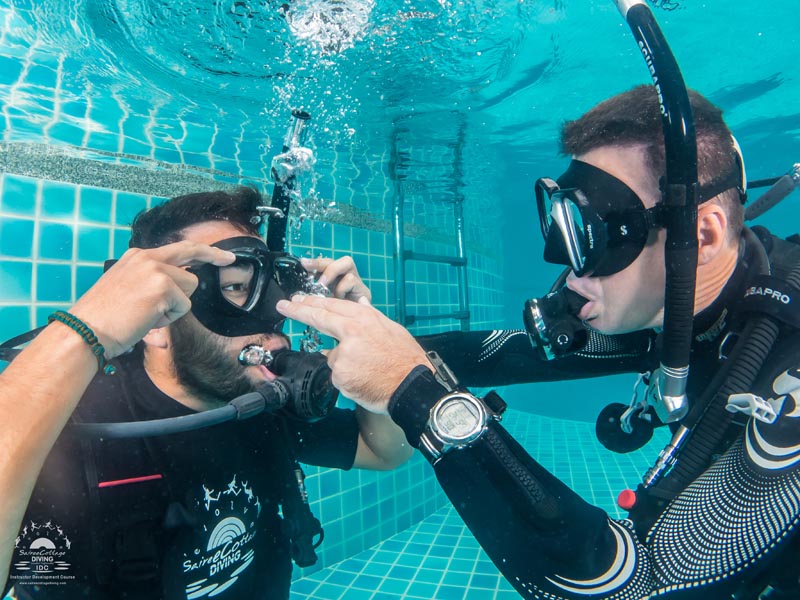
This order made complete sense to me and I certified over a thousand PADI Open Water Diver students this way. At one point however I noticed that the PADI Fully Flooded mask skill was not part of confined dive 2 (this was before the 2013 PADI Open Water Diver course revision). I decided at that time not to teach it anymore to see why PADI did not include this skill in confined water training and wow what it difference it made!
This was my new order: Partial flooded mask in confined dive 1, then in confined dive 2 I started with Mask Removal and Replacement followed by Mask Removal and Replacement for 1 minute (not teaching the fully flooded mask in confined). The first Open Water diver course I taught this way I noticed that none of my students had any issues with the mask. This could of course just be an open water diver course with good students. But after the next 5 PADI Open Water Diver courses with almost no more students having mask clearing problems, I started to see the difference.
I’m not 100% sure, but I think it has to do with that it is easier for people to just remove the mask underwater as they expect the same feeling of water around their face as when they swim or take a shower. If you flood the mask first, they have the water inside a box (their mask) closed up around their eyes and nose only. I believe this feels more scary as it is a new sensation and many people react to it by automatically breathing in through their nose, causing a panic reaction underwater. Not teaching the fully flooded mask in confined water before the revision changed everything for me and together with the other tips I almost had no more students divers with mask clearing problems.
In 2013 PADI revised the PADI Open Water Diver course and added a few more diving skills in confined and open water. I personally embraced the new PADI diving skills and think it significantly increases diver safety. However PADI did added the Fully Flooded Mask as a performance requirement in confined dive 2. For most PADI scuba instructors this didn’t matter as they taught the Fully Flooded Mask anyway in confined dive 2, but for me it meant I could no longer do my favourite teaching order mentioned above.
There is a way around this. Whilst you have to teach the confined water dives in order, you can mix up the skills within a confined water dive. To still get the positive results with your students mentioned before, I recommend you teach the mask skills in this order:
Confined Dive 1:
1. Partial Flooded Mask
Confined Dive 2:
2. Mask Removal and Replacement
3. Fully Flooded Mask
4. Mask Removal and Replacement for 1 minute
After step 2 students are more confident to clear the fully flooded mask in step 3. Remember for most people it is easier to remove the mask than to flood it first, because of the box effect.
Tip 6: Keep the mask clearing technique simple
Another teaching technique that has helped me greatly over the years is to keep the steps and mask clearing techniques simple. I know that it is important to over exaggerated on your demonstration but the PADI Mask Removal and Replacement skill is already a bit of a stressful skill for some of your students divers. Over-teaching the PADI Mask Removal and Replacement skill in the demonstration only leads to more confusion and stress. I recommend that you brief and demonstrate this skill in an easy manner with not too many steps.
Techniques like: flooding the mask first, looking down and forcefully clearing the mask while looking all the way up to the sky is not really needed and will properly not be used on a normal dive when people want to remove, replace and clear a mask. Personally I recommend these steps to my PADI Open Water Diver students:
- Remove the mask from your face
- Make sure the mask is the right way up
- Remove any hair from the face or forehead
- First replace the mask, and then the mask strap above the ears
- Gently put some pressure with 2 fingers on the top frame of the mask
- Exhale gently, but long while looking up a bit
Tip 7: “Many roads lead to Rome”
These tips to improve teaching the PADI Mask Removal and Replacement skill and the other mask skills can be used for PADI IDC candidates, New Dive Instructors, or Experienced Diving Instructors.
Everyone has a different teaching style and especially experienced PADI Diving Instructors usually already have a great way of teaching these PADI mask skills. This article is not written to say that these tips are the only way of teaching the PADI Mask Removal and Replacement skill. There are many different ways to teach the PADI mask skills. For me these techniques have greatly helped me over the years.
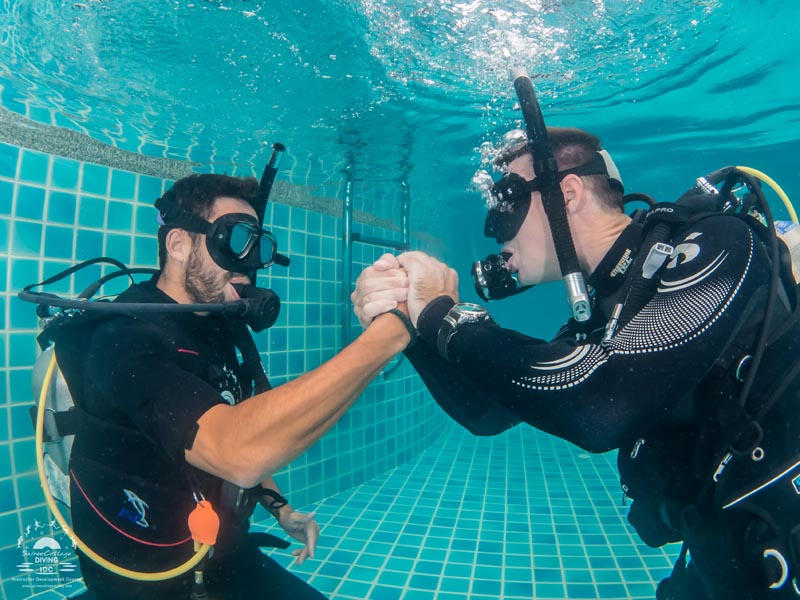
It’s all about experimenting and some techniques have worked very well for me, while other techniques not so much. I have also seen that some of these mask clearing teaching techniques work fantastically well with some dive instructors and a lot less with other dive instructors. My final tip is to at least try out my tips and see if they help, but keep experimenting and try out other suggestions from other instructors and see what works best for you and your diving students. Like the saying goes: “Many Roads Lead to Rome”.
Please share any of your tips that help student divers to perform the PADI Mask Removal and Replacement skill more easily in the comments below and please contact us if you would like to join our PADI IDC, MSDT or Dive Instructor Internship course

Marcel van den Berg
PADI Platinum Course Director
Sairee Cottage Diving
Koh Tao, Thailand
[fbcomments]
Like & Share

